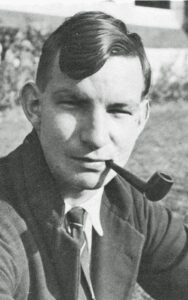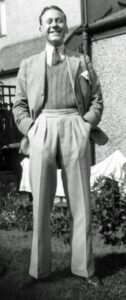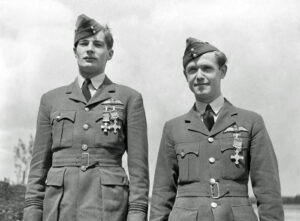Some Members of The Few: Part Two
The second blog by Geoff Simpson, a freelance writer who has studied the Battle of Britain for nearly 40 years. He has met, interviewed and corresponded with several hundred of “the Few”
Between July 10 and October 31, 1940, nearly 3000 aircrew flew with RAF Fighter Command and, in 1945, became eligible to wear the much-desired Battle of Britain Clasp. The dates are somewhat arbitrary but cover the key period when the German air force sought air superiority over southern England and the English Channel as a prelude to a possible invasion. Following a speech by the then prime minister, Winston Churchill, these Fighter Command fliers from a variety of countries became known as “the Few”.
This blog gives three more examples of members of the Few with Greater Manchester connections. Read Part One here.
Charles
Military awards tend to have a pot luck element. Dates and other qualifications are set and some people are lucky and some are not. Charles Harvey Bacon’s participation in the Battle of Britain was brief and in the North East rather than the front line of South East England. However, had he survived, he would have been entitled to wear the 1939-1945 Star with Battle of Britain Clasp.

He was born in 1919 in Chorlton upon Medlock. In 1929/30 the family home was Shawbrook Lodge, Burnage Lane, Withington.
Bacon’s father, William Charles Frederick Bacon, had been master of the sailing vessel Esperanza. He left the sea, aged 29, and gave his name to the firm of Sivewright Bacon & Co, shipowners and shipbrokers, based in West Hartlepool. The company moved to Manchester in 1897 having understood the prospects opened up by the Ship Canal.
In 1902 W C F Bacon became a director of the Manchester Ship Canal Company and, in 1916, Chairman. Charles Bacon was a child of his second marriage. After a period of illness, W C F Bacon died in January 1931 at Ashford, Alderley Road, Wilmslow.
Charles Bacon was educated at Sedbergh School and went up to Magdalen College, Oxford, becoming a research chemist and a demie (half fellow). He joined the Oxford University Air Squadron, later transferring to the Royal Air Force Volunteer Reserve.
Called up on 1 September 1939, two days before the outbreak of war, Bacon initially flew Fairey Battle bombers. The Fairey Aviation company had a significant presence in Heaton Moor, Stockport and at Ringway.
Bacon was in France and was a survivor when the RMS Lancastria was bombed and sunk, with enormous loss of life, while evacuating British troops and civilians from St Nazaire on 17 June 1940.
He became a Spitfire pilot and joined No 610 (County of Chester) Squadron at Acklington, Northumberland on 16 September 1940. Two weeks later, during dogfight practice, the aircraft of Flying Officer Bacon collided with that of Sergeant H R Clarke. Bacon was killed, his Spitfire crashing on Alnmouth beach. Clarke came down by parachute and survived.
Charles Bacon is buried in Windermere (St Mary’s) cemetery. The private gravestone demotes him to Pilot Officer.
Norman
Norman Bagshaw Heywood also flew Fairey Battles before he volunteered to become a fighter pilot, going on to serve with three Hurricane squadrons in the Battle of Britain. He was born in Timperley in August 1918. When he was a few weeks old his father was killed flying with the RAF on the western front.

Heywood gained a civilian flying certificate at Brooklands in Surrey and then joined the RAF on a short service commission.
On 22 October 1940, Pilot Officer Heywood, piloting a Hurricane of No 257 Squadron, based at Martlesham Heath, Suffolk, was in combat with German fighters over Folkestone. His aircraft was hit by “friendly” anti-aircraft fire and crashed south of Lydd church on Romney Marsh. Heywood’s body was recovered and he lies in a family grave in Stretford cemetery.
Kenneth
Heaton Moor in 1918 was the birthplace of Kenneth Hughes Blair. He also entered the RAF with a short service commission before the Second World War, going on to join the No 85 Squadron. He flew Hurricanes with the squadron in the Battle of France. On 10 May 1940, the day on which German forces, using the ”Blitzkrieg” (lightning war) technique, attacked France and the Low Countries, Flying Officer Blair shot down one German bomber and was credited with a share in the destruction of another.

At the end of the month, it was announced that he had been awarded the Distinguished Flying Cross (DFC).
Blair became a flight commander on No 151 Squadron, with the rank of acting Flight Lieutenant. He fought through the Battle of Britain achieving much more success in the aerial battles.
Later in the war, Kenneth Blair commanded a squadron of de Havilland Mosquitos, carrying out low-level attacks on specific buildings. He was awarded a bar to his DFC He continued in the RAF after the war and reached the rank of Wing Commander. However, he contracted polio and died in 1953. He is buried at Hatfield cemetery, south Yorkshire.







